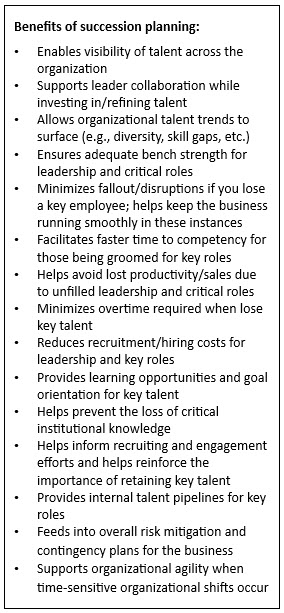How to Craft Your Business Case for Succession Planning

Additional contribution from Aisha Wright-Burke, Ed.D., Director, Talent Solutions ADP
Succession planning is a vital human capital process for identifying, developing and retaining internal leadership and the talent needed to fill critical roles. Yet many organizations have not proactively created a formal, automated succession planning program. A robust business case can help catalyze the process.
What is succession planning and why is it important?
Succession planning is the process of identifying, developing, and retaining internal talent to replace leadership and other critical roles when employees take a leave of absence, resign, retire, vacate the role through internal movement or otherwise exit the company. This process complements process mapping and replacement planning processes that aid in capturing organizational knowledge and having contingency plans in place for the near term.
Succession planning ensures that companies have the future human capital needed to operate the business. Without succession planning, the organization could be one person away from disorganization or chaos should that person unexpectedly leave. "Companies routinely plan how to address emergency scenarios that would impact the business (e.g., server disruption). Succession planning should be no different. It's vital for business continuity. Talent is one of our greatest assets," shares Aisha Wright-Burke, Ed.D., ADP's Director of Talent Solutions. Write-Burke is responsible for ADP's internal succession planning process globally.
Organizations of any size should engage in a thoughtful, proactive succession planning process. The end result should be a formal, documented succession plan that is an integral part of organizational strategy. Yet according to research from the Society of Human Resource Management (SHRM), only 24 percent of organizations have a formal succession plan in place. The purpose of this article is to help organizations that haven't yet formalized or automated their succession plan to craft a business case for an automated, formal succession planning process within their companies.
Elements of the business case
The business case for succession planning can take the form of a PowerPoint presentation, a Word document, or some combination. Provided here are the suggested elements to create a compelling business case that can be used to convince leadership and key stakeholders of the value of formal, automated succession planning.
1. Executive summary
An executive summary is a one- or two-page recap of the most important elements of the business case (sections following) for the executive reader and/or decision maker(s). Oftentimes the executive reader may not have time to consider all the details, so the executive summary hits the high points, and the additional detail can be provided in an appendix. When crafting an executive summary, a good rule of thumb to consider is the "BLUF" approach; that is, putting the bottom line up front (e.g., the key points).
2. Problem statement
Next in crafting a business case for succession planning is the articulation of the problem statement. "Developing a compelling problem statement in the language of your major stakeholders can positively impact your approach," shared Wright-Burke. This statement should answer the question: What is the business problem you are trying to solve? For example, a problem statement could be: "Our organization has identified critical roles where our workforce is aging and there are no identified successors. This presents a significant risk to the company in terms of knowledge loss and potential revenue impact as workers start to retire in these roles."
3. Current state/Proposed future state
In the next section of the business case, the organization should summarize the current situation as well as the desired future-state objectives. As part of the current state, it is helpful to articulate the present challenges, pain points and any existing processes in place. "Understanding the needs and desires of your stakeholders in the business is critical. Think about what's most important to them in terms of a future-state process and socialize preliminary ideas with them for their feedback," shared Wright-Burke.
For the envisioned future state, what is the solution that you are requesting, and how will it help to solve the identified challenge(s)? For example, the succession planning process at your company may currently be manual (i.e., completed via Excel spreadsheets), and the organization has grown to the point where manual processes are very time-intensive and are ineffective in identifying and developing diverse talent pools. An envisioned future state request could be to automate your succession planning processes with integrated tools and data as part of a larger talent suite of solutions to develop proactive, formalized and documented succession plans for key leadership and critical roles company-wide.

.
.
4. Cost/Benefit analysis
The cost/benefit analysis section of the business case is often the one that leaders are most interested in to answer the questions: How much will the proposed solution cost and what will it save the organization? Costs for a future automated solution, for example, include the straightforward explicit costs of a digital solution. Other costs include any additional resources (e.g., internal people resources/time, consulting fees, IT support, etc.) that you will need to implement the new succession planning initiative.
Benefits may be intangible and tangible. The intangible benefits of succession planning are many and varied.
Quantifying the benefits/savings of the succession planning initiative may be more difficult. Some potential "eye-opening" questions to ask include:
- Do you know how many individuals in your organization are close to retirement? How hard will it be to find and train replacements for those roles?
- How regularly does your company analyze turnover rate trends for critical roles?
- What are the risks to the company of losing people in key or critical positions?
- What would be the cost of lost productivity or sales if an individual in a leadership or critical role left the organization without a successor(s) being identified?
- What is the estimated value of knowledge that would be lost to the organization if an individual in a leadership or critical role left the organization without a successor(s) to whom that knowledge was to be transferred being identified?
- If the succession planning process is primarily manual, how long is it presently taking you to compile, analyze, and report on the information presented and leverage the data throughout the year? What would be the labor time/cost savings in the future, proposed automated process?
5. Proposed measures of success
A good business case for succession planning should suggest key performance indicators (KPIs) to be used as gauges of improvement. "The ability to know your talent planning initiative successes, gaps and opportunities through data can be powerful in reinforcing behaviors and inciting the action and resources needed for change," said Wright-Burke. Some examples can include (as it pertains to leadership or key roles):
- Internal promotion rate
- Average time to promotion
- Internal mobility rate
- Diversity statistics of talent pools
- Satisfaction/engagement scores with respect to development opportunities
- Turnover/retention rates
- Percentage of leadership/key roles with succession plans in place
- Percentage of targeted vacancies filled by talent pool candidates
- Number of ready-now successors
6. Action plan and next steps
In the final summary section of the business case for succession planning, the company should outline the proposed timeline and anticipated milestones. To support the business case, a more detailed project plan with specific tasks and roles should be created and made available.
Conclusion
Succession planning is a vital human capital process for identifying, developing and retaining internal leadership and the talent needed to fill critical roles. Yet many organizations have not proactively created a formal, automated succession planning program. A robust business case with the points discussed above can help catalyze the process for finance, HR and/or other senior leadership stakeholders.
Additional resources
- Learn more about succession planning and get answers to frequently asked questions.
- What Does an Ideal Process for Succession Planning Look Like
- A Beginner's Guide to Business Succession Planning for Small-and Mid-Sized Business Owners
- Future Proof Your Management Team: Balancing Promotion and Succession Planning



